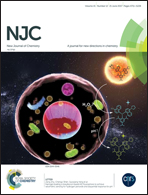Synthesis and structural diversity of d10 metal coordination polymers constructed from new semi-rigid bis(3-methyl-1H-pyrazole-4-carboxylic acid)alkane ligands†
Abstract
Three isomeric bis(3-methyl-1H-pyrazole-4-carboxylic acid)alkane ligands (H2L1, H2L2 and H2L3) were prepared via a two-step process from ethyl 3-methyl-1H-pyrazole-4-carboxylate (1). They were introduced as bridging ligands to assemble with Zn(II) and Cd(II) ions, and two chiral coordination polymers [Zn(L1)(DMF)(H2O)]n (3a and 3b), [Cd(L1)(H2O)]n·nH2O (5) and two achiral coordination polymers [Zn(L1)(H2O)2]n·nH2O (4), [Cd(L2)(H2O)]n·2nH2O·nEtOH (6) were obtained. (L1)2− adopts a trans-conformation in 3, leading to the formation of 1D coordination chains, and the 2D coordination layers in 4–6 are constructed from (L1)2−/(L2)2− anions in a cis-conformation. Notably, the structures of 3a and 3b exhibit an H-bonded chiral 2D network, featuring a right-handed 3-fold helix in 3a, while a left-handed 3-fold helix in 3b. Compound 5 possesses a 3D supramolecular network with homochiral left-handed helical chains, whose chirality is due solely to the hydrogen bonds. The chiral nature of enantioenriched 3a produced by diffusion crystallization was confirmed by solid-state CD spectroscopy. The thermal and luminescence properties of 3–6 in the solid state have also been investigated.



 Please wait while we load your content...
Please wait while we load your content...